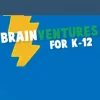Take a look inside 6 images
BrainVentures
Pros: Students explore fun topics in a variety of ways.
Cons: The student experience can be confusing, particularly for younger kids; not much flexibility to adjust activities.
Bottom Line: This could be a nice solution for teachers wanting to hand over student-led, prepackaged learning bundles, though they'll need to provide lots of support.
Students can explore BrainVentures on their own in the classroom. Or, BrainVentures can be particularly useful for helping guide students in their own individual exploration at home. If teachers assign the same unit to the class, students can make their way through the learning roadmap, and then teachers can follow up with additional whole-class discussion or other activities. Because navigation isn't always intuitive, teachers will want to demonstrate how to work through the learning path first, and be available for troubleshooting.
Use BrainVentures as a way to introduce topics -- or a way to approach topics if students create their own roadmap for a flipped classroom. For instance, have students complete the lesson on whether or not sharks are superheroes or supervillains. Then, direct them to other resources to do more research, have a debate in class using what they've learned, or use it as a way to start looking at comparing and contrasting ideas.
BrainVentures is a project from the University of Michigan's Center for Digital Curricula that offers free, self-guided, prepackaged learning units full of web resources, writing prompts, games, and more. Topics cover a wide range such as Animals, Social Studies, Art, and Life Skills, and are divided into two age groups: grades K–2 and grades 3–6. The BrainVentures start with a guiding question such as "What's inside a pyramid?" and then present what the developers call Road Maps, or paths for discovering the response to the main question. Each stop on the path offers a link to a learning activity, some of which are third-party web resources while some were created with a set of the developer's applications called Collabrify. Web resources tend to be informational websites for kids (e.g., National Geographic), or YouTube videos. The Collabrify pieces combine listening, watching, and reading with options that allow students to provide their own input as they answer open-ended comprehension questions, create animations to show what they've learned, and more. As students finish each stop on the path, they check the box to mark it as complete. To access the BrainVentures, all users must sign in with a Google account; progress is saved in the user's Google Drive. In addition to Google products, the developers claim that the work is compatible with Schoology and other digital classroom spaces.
BrainVentures uses fun questions to pique students' interest, and then uses multimedia resources to keep kids interested. Videos, writing prompts, interactive websites, and more help engage students in different ways and encourage active exploration. The learning approach draws clearly on project-based and inquiry-based learning theories. With Google Classroom integration, cool topics, and varied resources, there's quite a bit here for teachers to use for free.
Yet, though the developers label their material as being appropriate for K–6, it's difficult to see younger students being successful. There's a text-to-speech option for some parts of the learning path, but outside resources often don't have one. So students need to be confident readers. Also, the user experience and navigation are both unwieldy and sometimes confusing, which may put some students off. And, unfortunately, sometimes links to third-party resources are stale, or access to sites is no longer valid, which can interfere with students being able to experience the full learning journey. As progress is saved in the user's personal Google account, there's also little clarity on how teachers can access what students do. Finally, some teachers and students may have no problem continually signing in to their Google account to access the BrainVentures, but others may find it onerous, confusing, or even prohibitive.















